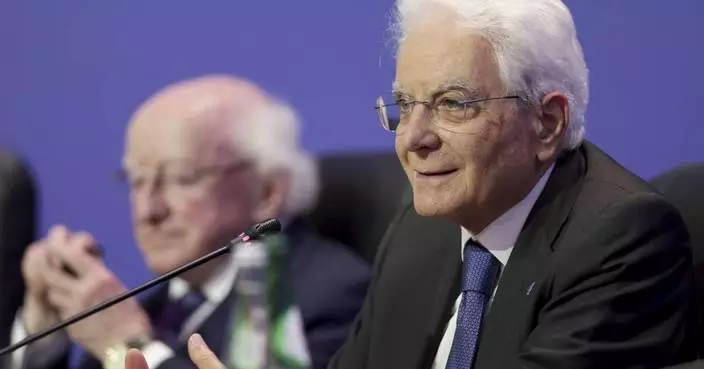Prada CEO Patrizio Bertelli said Friday the family-owned Italian fashion group has no intention of selling and that his elder son with co-CEO and creative director Miuccia Prada is being groomed to take over.
Bertelli said during the unveiling of a handbag production site near Florence that his 30-year-old son Lorenzo "is preparing so that one day he can become the head of Prada," assuming that once he has learned the ropes he also still has "the desire to do it."
Click to Gallery
Prada CEO Patrizio Bertelli said Friday the family-owned Italian fashion group has no intention of selling and that his elder son with co-CEO and creative director Miuccia Prada is being groomed to take over.
Lorenzo started working in the communications department in September.
He did not say when he or Miuccia, 69, would consider stepping aside.
The Gianfranco Ferre brand has virtually disappeared after a period of receivership and then purchase by a Middle Eastern group. Jil Sander, which Prada briefly held, has changed designers several times since Sander gave up control. Roberto Cavalli is on its second designer after the founder turned over control to a private equity firm.
The 32,000-square-meter site is integrated with pools of water and blooming jasmine, grapevines, pomegranate trees and other greenery both to improve the experience of its nearly 800 employees and to help the environment by absorbing 20 tons of CO2 a year, the CEO said. It is one of 10 Prada factories in Tuscany.
Bertelli said the best way for the brand to respond to trends is to completely control production sites. Prada owns 35 percent of its production sites, 80 percent of which are in Italy -- bucking what he said was the sector trend of outsourcing production.
Like other fashion brands, Prada is targeting millennials, the generation born before 2000 and who are up to 35 years old now — encompassing the ages of Bertelli's two sons. They are responsible for 60 percent of Prada sales, and will inevitably tip the luxury market even more toward China, where there are 400 million millennials, compared with 80 million in the United States, he said.
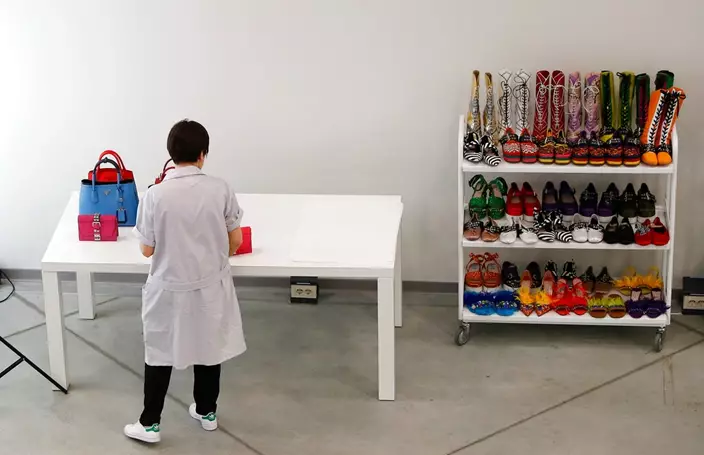
A woman works at Prada's new industrial headquarters and production site, in Valvigna, Italy, Friday, June 8, 2018. (AP Photo/Antonio Calanni)
Lorenzo started working in the communications department in September.
While other Italian companies, including fashion brands, have sold when facing generational change, the 72-year-old Bertelli said "I have no intention to sell." Nor is he looking to expand the Prada Group, which also includes the Miu Miu fashion brand, Church's and Car Shoe footwear brands and the Marchesi pastry company, with fresh acquisitions.
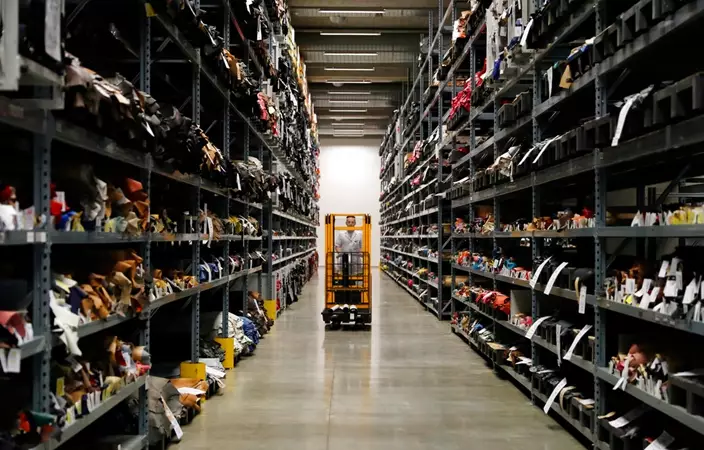
Items are lined up on shelves at Prada's new industrial headquarters and production site, in Valvigna, Italy, Friday, June 8, 2018. (AP Photo/Antonio Calanni)
He did not say when he or Miuccia, 69, would consider stepping aside.
"I think that retirement is tied to the physical and mental state of a person, and if one is efficient," he said, adding: "Retirement is a silly myth of a society that is old in principal."
Past examples show that the transition from the founding generation is not always a successful one, with the creative transition often the toughest.
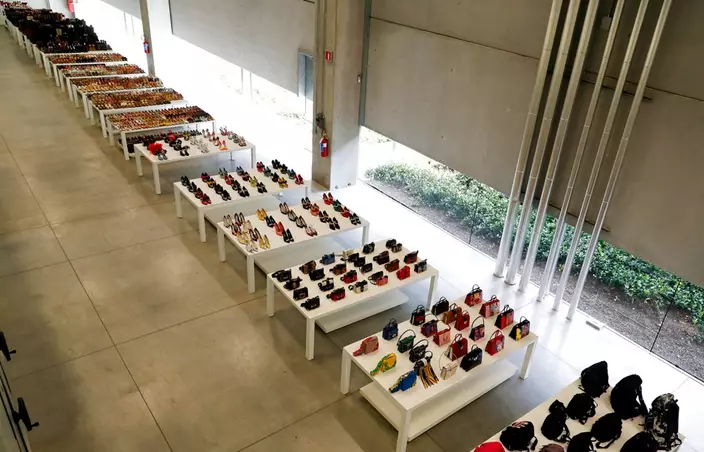
Shoes and bags are lined up at Prada's new industrial headquarters and production site, in Valvigna, Italy, Friday, June 8, 2018. (AP Photo/Antonio Calanni)
The Gianfranco Ferre brand has virtually disappeared after a period of receivership and then purchase by a Middle Eastern group. Jil Sander, which Prada briefly held, has changed designers several times since Sander gave up control. Roberto Cavalli is on its second designer after the founder turned over control to a private equity firm.
Bertelli unveiled the new site in the Arno Valley where the fashion group develops the sought-after Prada and Miu Miu handbags and leather accessories.

A view of Prada's new industrial headquarters and production site, in Valvigna, Italy, Friday, June 8, 2018. (AP Photo/Antonio Calanni)
The 32,000-square-meter site is integrated with pools of water and blooming jasmine, grapevines, pomegranate trees and other greenery both to improve the experience of its nearly 800 employees and to help the environment by absorbing 20 tons of CO2 a year, the CEO said. It is one of 10 Prada factories in Tuscany.
The handbag is key to Prada's success, comprising 60 percent of its revenues, with the rest split largely between ready-to-wear and footwear. Prada is forecasting a return to sales growth this year after several years of profit decline.
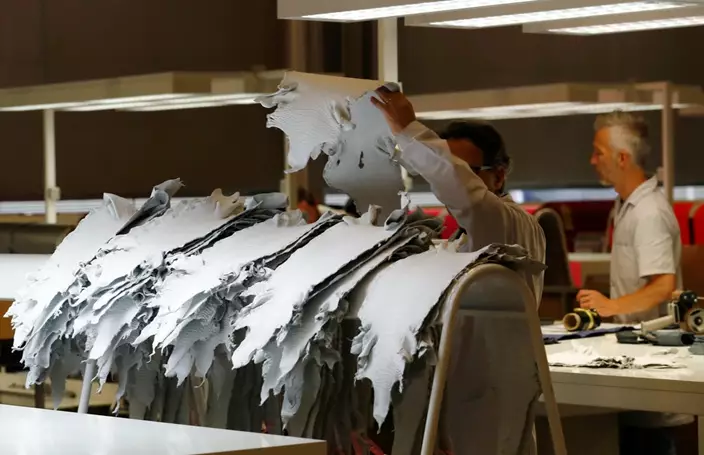
A man works at Prada's new industrial headquarters and production site, in Valvigna, Italy, Friday, June 8, 2018. (AP Photo/Antonio Calanni)
Bertelli said the best way for the brand to respond to trends is to completely control production sites. Prada owns 35 percent of its production sites, 80 percent of which are in Italy -- bucking what he said was the sector trend of outsourcing production.
He would not say how much the Valvigna plant investment cost, only saying that it was less than 70 million euros ($82 million) -- 2 million euros of which were for the greenery.
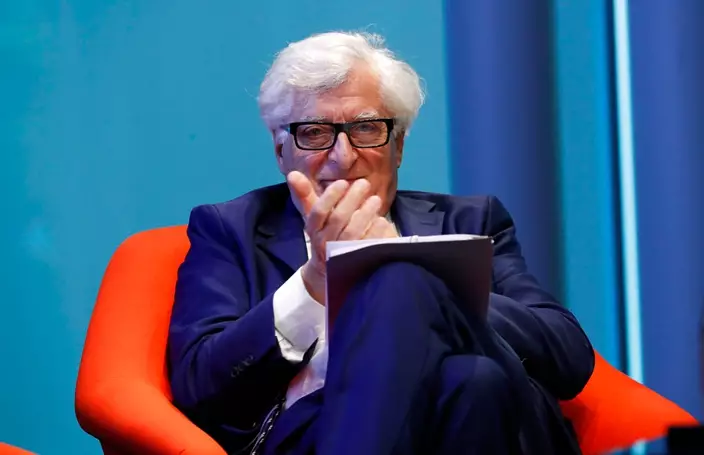
Patrizio Bertelli attends a press conference at Prada's new industrial headquarters and production site, in Valvigna, Italy, Friday, June 8, 2018. (AP Photo/Antonio Calanni)
Like other fashion brands, Prada is targeting millennials, the generation born before 2000 and who are up to 35 years old now — encompassing the ages of Bertelli's two sons. They are responsible for 60 percent of Prada sales, and will inevitably tip the luxury market even more toward China, where there are 400 million millennials, compared with 80 million in the United States, he said.

Patrizio Bertelli attends a press conference at Prada's new industrial headquarters and production site, in Valvigna, Italy, Friday, June 8, 2018. (AP Photo/Antonio Calanni)
After Gucci — owned by the French conglomerate Kering — unveiled to the investment community this week a video showing a robot making shoes, Bertelli said such production didn't fit his notion of luxury.
"To make a luxury product, like a handbag, it is not possible," Bertelli said, while conceding that it could be done for more casual footwear like sneakers.
TORGIANO, Italy (AP) — The Prada Group is expanding its production footprint in Italy, including dozens of new jobs at its knitwear factory in Umbria, leaning into “Made in Italy” as integral to the brand’s ethos and developing new artisanal talent to ease the luxury group through a generational shift in its workforce.
Prada CEO Andrea Guerra, who was brought in last year as part of the generational change in family-run Prada’s management, said at an unveiling of the expanded plant Tuesday that the company is investing 60 million euros ($65million) in production this year.
At Torgiano, Prada has added 30 new jobs this year, alongside 65 last year, bringing the workforce to some 220 employees, mostly women, to create knitwear for the Prada and Miu Miu brands, a key category for the group. The site had just 39 employees when Prada bought it in 2001.
“For many years, Torgiano was a small, important place, linked to the Umbrian knitwear tradition,’’ mostly dedicated to product research and development, Guerra said. “In the last six or seven years, with the extraordinary growth in knitwear, we decided to create an all-around industrial hub," adding production to a reinforced R&D center.
The innocuous low-slung plant, identified by a simple, small Prada nameplate near the gate, is at the heart of a network that includes dozens of smaller companies that together create some 30,000 pieces of knitwear a month for the global luxury group. They include pretty, red crocheted Miu Miu culottes to soft gray Prada cardigans that have become a trademark.
Guerra described the Milan-based fashion group’s manufacturing footprint in central Italy as a “network of intelligent relationships and craftsmanship merged with a constant capacity to bring innovation to the market.”
Prada’s investments to exert greater control over its supply chain stand out against the backdrop of a recent investigation that revealed sweatshop conditions in Chinese-owned factories producing luxury goods for other Italian brands in the Lombardy region, where the Italian fashion capital Milan is located. The production arm of Giorgio Armani has been put under receivership as part of an ongoing supply chain probe.
Prada has focused on what it calls vertical integration of its supply chain — working with smaller companies, some with just a handful of craftspeople, that provide specific, sometimes unique, skills. For its knitwear operation, Prada works with some 60 smaller companies that it refers to as “partners” or “collaborators."
“Contractors, subcontractors, that is not something tied to this world. There are production phases that are assigned to our collaborators, our partners,’’ Guerra said, adding: “The way I work inside, and the way I work outside needs to be the same.”
Lorenzo Bertelli, marketing director and head of corporate social responsibility who is slated to take over the company from his parents Patrizio Bertelli and Miuccia Prada, said a strong governance is the key to avoiding “such incidents.” He credited his father with starting Prada on the road to integrating its supply chain in the 1990s.
Audits of suppliers, which have so far been voluntary, will become mandatory in 2025 under the Corporate Sustainability Reporting legislation, aimed at controlling abuses, said Stefania Saviolo, a fashion and luxury expert at Milan’s Bocconi University. Publicly quoted companies like Prada, which are used to a level of transparency and reporting, will likely have an easier time than others, she said.
Integrating the supply chain doesn’t just mean that a major player buys up smaller companies, she said, but they may invest in specific machinery, or help them secure bank financing. “It is not ownership, it is a longer transaction along the model of partnership,’’ Saviolo said, adding that such relationships also provide a sense of security to the smaller companies more vulnerable to market crashes.
Noting that the luxury and fashion industries have long relied on third-party manufacturing, Bernstein global luxury goods analyst Luca Solca said the kind of investments by Prada to integrate manufacturing processes in-house “is a sort of catch-up with best-in-class-players in the industry.”
A key part of Prada’s investments are aimed at securing know-how into the next generation, a transition the company has been preparing also in its management and creative roles.
Finding new workers with both experience and passion is difficult, even in a region where knitwear is part of the local tradition, said Lorenzo Teodori, who runs the Torgiano plant.
To fill that gap, Prada runs an internal academy as needed at its 23 Italian production sites to train young craftspeople. The next one in Torgiano starts in the fall, with experienced workers training the next generation.
“Through the Prada Academy, we have seen how this dialogue is still alive and successful,’’ Bertelli said. “We need it to train the future technicians of tomorrow, who in turn will be the teachers in the future. It is a fundamental cycle for our group.”

Italian artisans create knitwear for the Prada and Miu Miu brands at a recently expanded factory in the Perugia province of Italy Tuesday, May 7, 2024. The Prada Group is expanding its production footprint in Italy, including dozens of new jobs at brand's knitwear factory near Umbria, leaning into Made in Italy as integral to the brand's ethos as it develops new artisanal talent to ease the luxury group through a generational shift in its workforce, alongside the management and creative transitions already under way. (AP Photo/Colleen Barry)
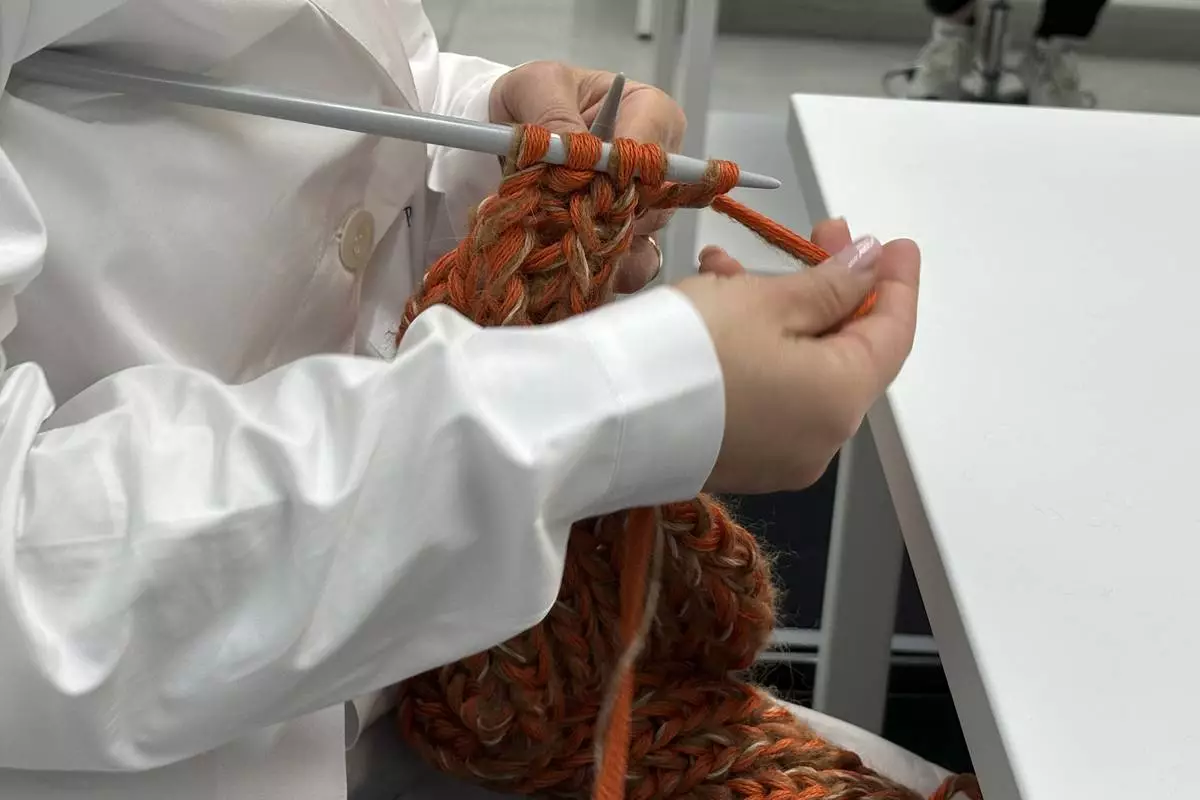
Italian artisans create knitwear for the Prada and Miu Miu brands at a recently expanded factory in the Perugia province of Italy Tuesday, May 7, 2024. The Prada Group is expanding its production footprint in Italy, including dozens of new jobs at brand's knitwear factory near Umbria, leaning into Made in Italy as integral to the brand's ethos as it develops new artisanal talent to ease the luxury group through a generational shift in its workforce, alongside the management and creative transitions already under way. (AP Photo/Colleen Barry)
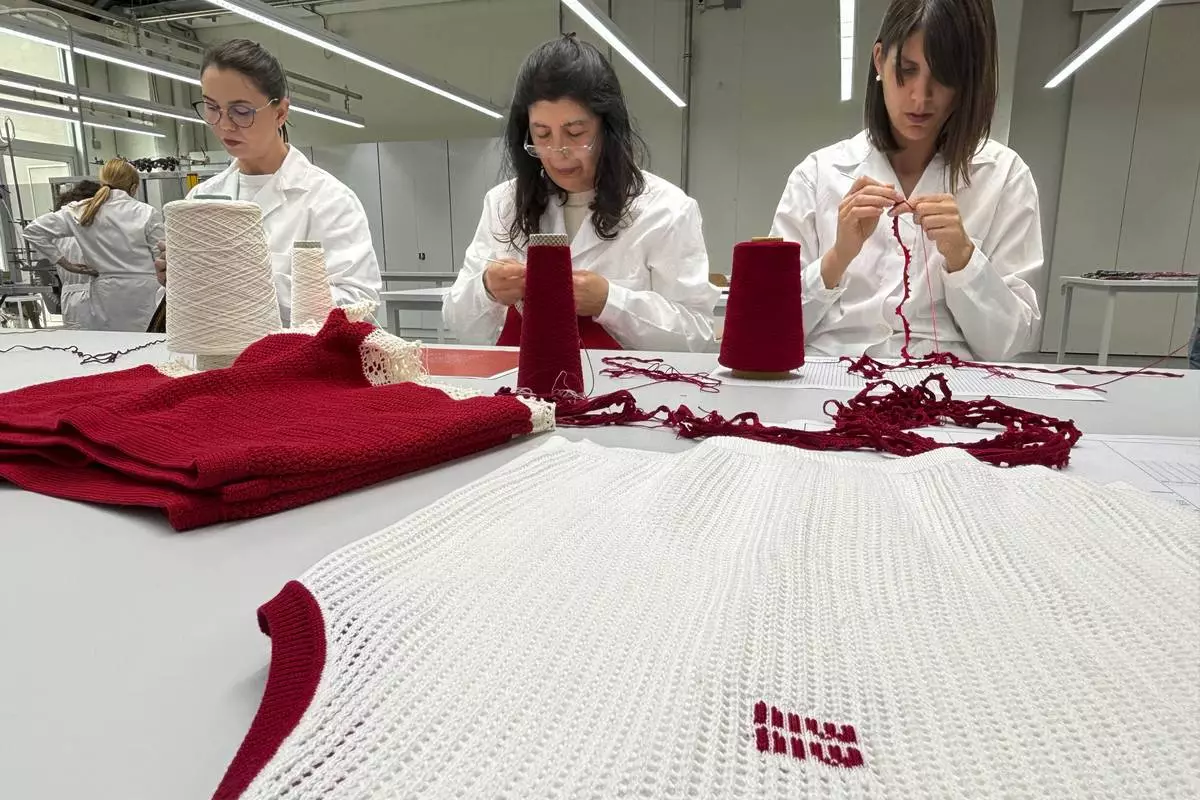
Italian artesans create knitwear for the Prada and Miu Miu brands at a recently expanded factory in the Perugia province of Italy Tuesday, May 7, 2024. The Prada Group is expanding its production footprint in Italy, including dozens of new jobs at brand's knitwear factory near Umbria, leaning into Made in Italy as integral to the brand's ethos as it develops new artisanal talent to ease the luxury group through a generational shift in its workforce, alongside the management and creative transitions already under way. (AP Photo/Colleen Barry)
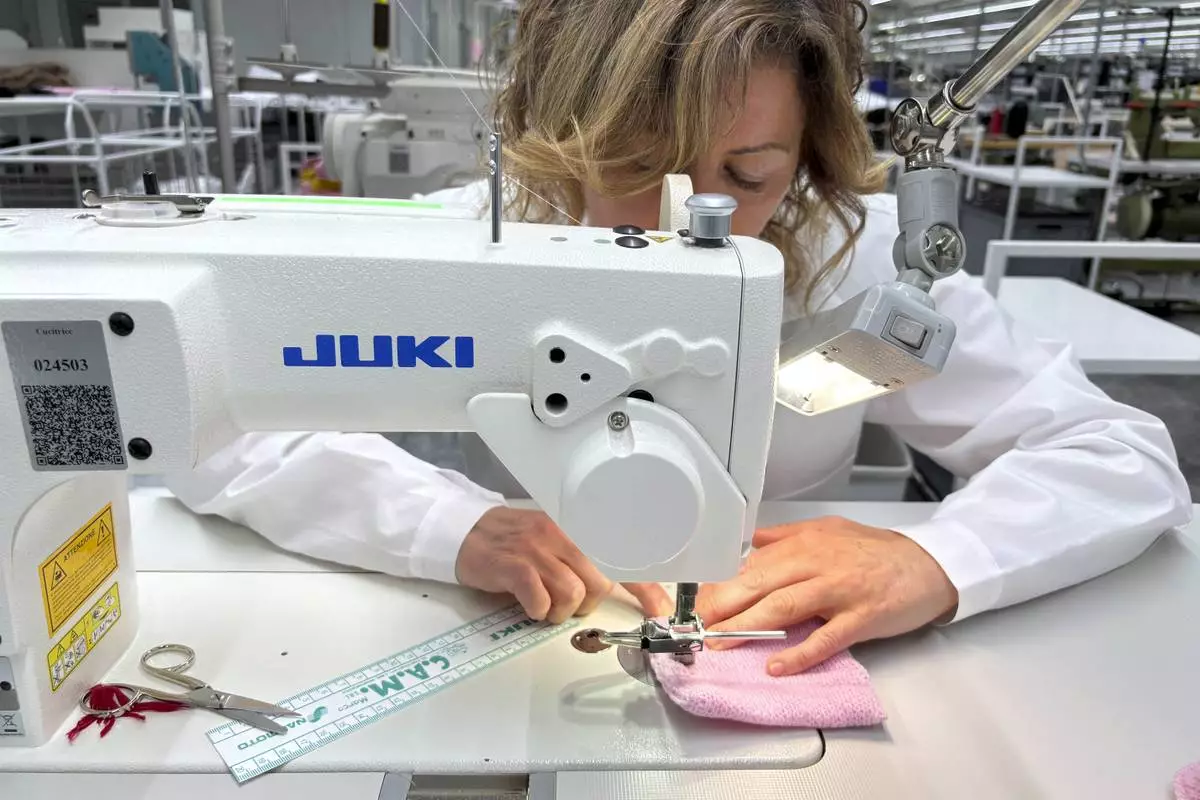
Italian artisans create knitwear for the Prada and Miu Miu brands at a recently expanded factory in the Perugia province of Italy Tuesday, May 7, 2024. The Prada Group is expanding its production footprint in Italy, including dozens of new jobs at brand's knitwear factory near Umbria, leaning into Made in Italy as integral to the brand's ethos as it develops new artisanal talent to ease the luxury group through a generational shift in its workforce, alongside the management and creative transitions already under way. (AP Photo/Colleen Barry)
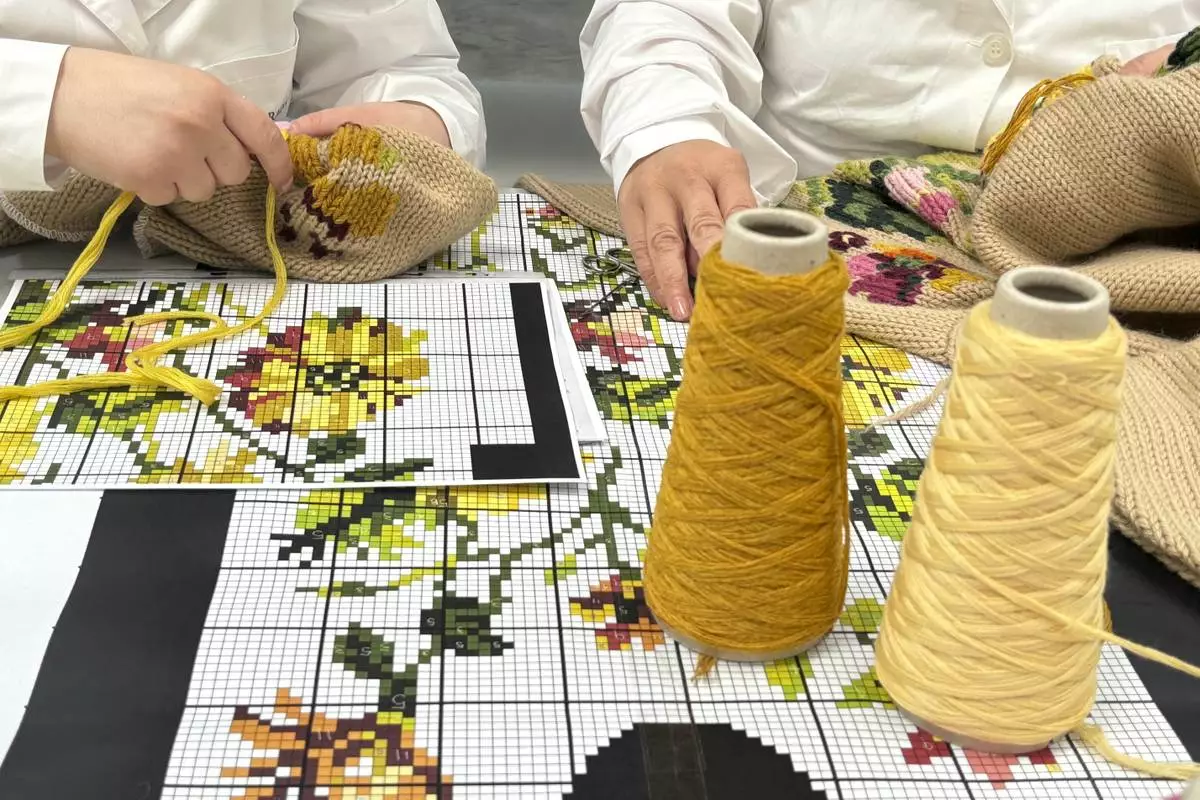
Italian artesans create knitwear for the Prada and Miu Miu brands at a recently expanded factory in the Perugia province of Italy Tuesday, May 7, 2024. The Prada Group is expanding its production footprint in Italy, including dozens of new jobs at brand's knitwear factory near Umbria, leaning into Made in Italy as integral to the brand's ethos as it develops new artisanal talent to ease the luxury group through a generational shift in its workforce, alongside the management and creative transitions already under way. (AP Photo/Colleen Barry)
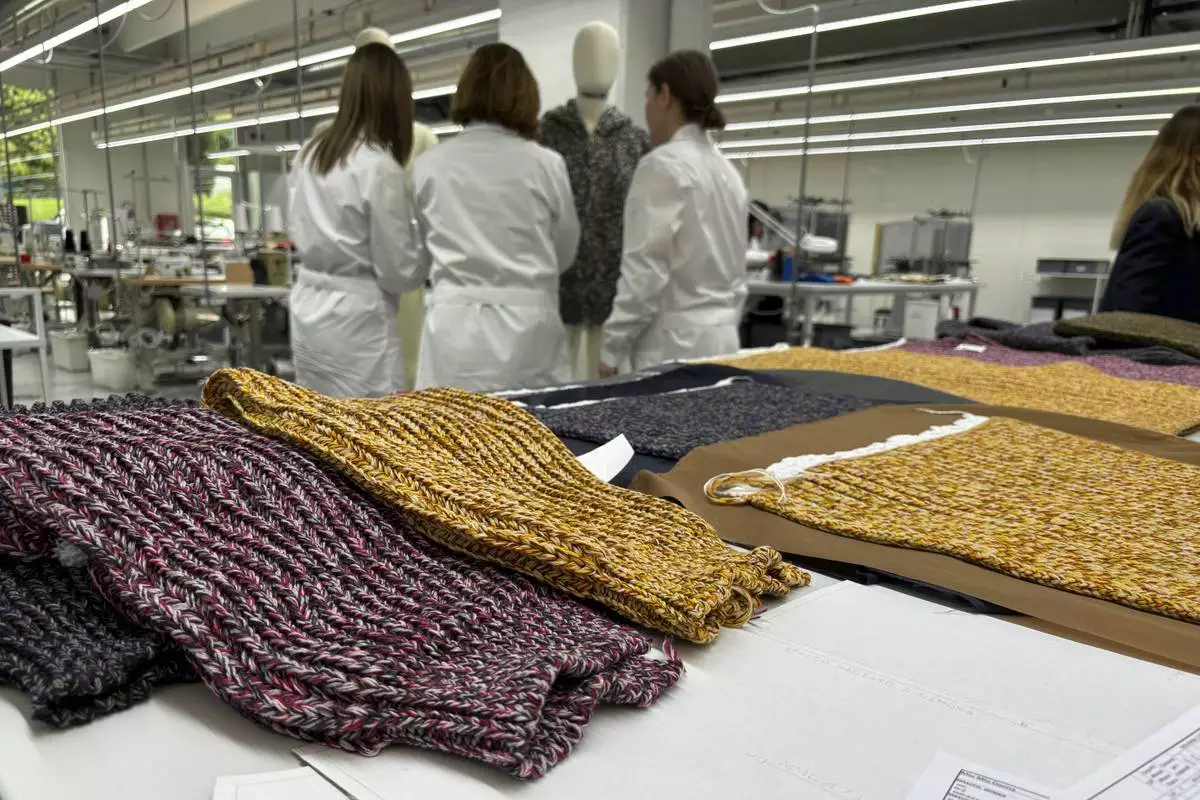
Knitwear created by Italian artisans for the Prada and Miu Miu brands sit on a desk at a recently expanded factory in the Perugia province of Italy, Tuesday, May 7, 2024. The Prada Group is expanding its production footprint in Italy, including dozens of new jobs at brand's knitwear factory near Umbria, leaning into Made in Italy as integral to the brand's ethos as it develops new artisanal talent to ease the luxury group through a generational shift in its workforce, alongside the management and creative transitions already under way. (AP Photo/Colleen Barry)

















